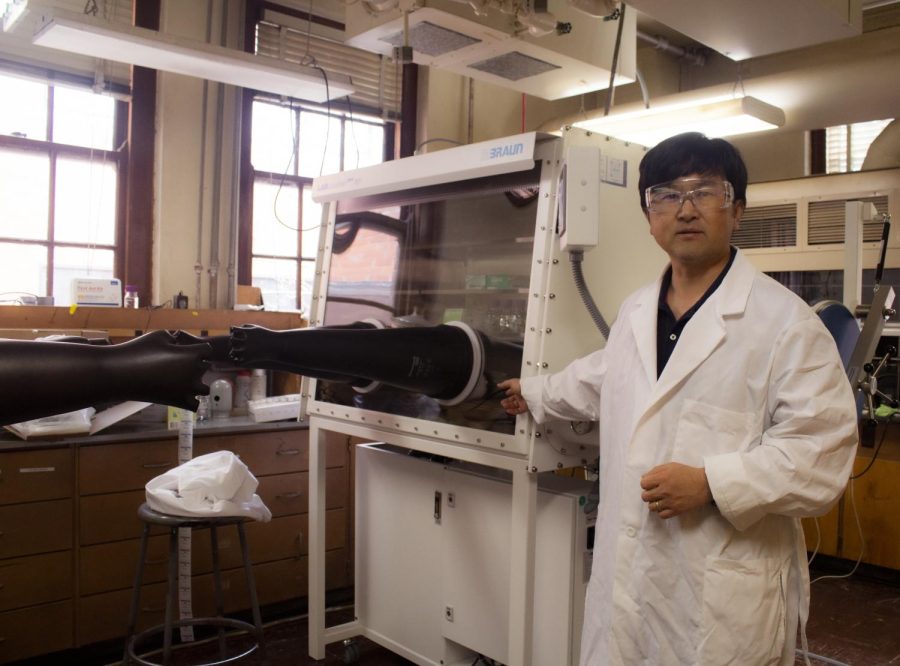New zinc battery research at OSU offers improved renewable energy storage
Xiulei “David” Ji (he/him), professor of chemistry at Oregon State University, explains his research on April 13 at OSU in Corvallis. Zinc battery research works to improve the sustainability of energy storage as an alternative to commonly-used lithium ion batteries.
May 1, 2023
Eighty-degree weather in April is unheard of in Corvallis, but look no further than the second floor of Gilbert Hall, where Xiulei “David” Ji, professor of chemistry at Oregon State University keeps his zinc batteries nice and toasty.
The batteries, arrayed on a special shelf in a small workroom with controlled conditions, undergoing charging tests, have increased in efficiency to nearly 100% after Ji and his collaborators created a new electrolyte to be used in their zinc metal anodes–which is one step closer to solving renewable energy storage.
Ji, the primary investigator of this National Science Foundation-funded research project and co-author of the research paper, said the uniqueness of the battery lies in the use of an aqueous, or water-based, electrolyte in the anode – which is the positive electrode in this case.
Published in Nature Sustainability, an online research journal, on March 23, the paper was co-authored by a handful of OSU researchers and researchers from other universities, as well as individuals from Hewlett-Packard Corvallis and GROTTHUSS Incorporation, an OSU spinout company.
Zinc batteries can serve as a tantalizing alternative to lithium-ion batteries for storage of renewable energy, since lithium-ion batteries pose safety concerns. Lithium-ion powered scooters have caused explosions from Medford, OR to the Bronx, NY.
“This battery is not explosive, it’s non-flammable and potentially cost-effective,” Ji said.
Although Ji said a lithium-ion battery’s cycle life is “pretty impressive,” allowing it to have a lifespan of around 8 to 10 years before needing replacement, one of the most important motivations for him and other researchers is to work on non-flammable alternatives.
“The fatal issue of lithium-ion batteries is its safety,” Ji said.
Ji said lithium is also relatively rare, and researchers want to save it for transportation.
The zinc battery that OSU researchers created shows a competitive efficiency to the long-used lithium-ion battery.
“Coulombic efficiency” refers to the rate at which electrons flow between the anode and cathode in a battery. The lower the CE, the more the battery’s efficiency will decrease after each cycle of electron flow.
Lithium-ion batteries have been developed by researchers for about 30 years, and have reached an efficiency of over 99%. The electrolyte developed to be used in zinc metal anodes by Ji, other OSU researchers and collaborators including scientists at Massachusetts Institute of Technology, Pennsylvania State University and University of California, Riverside, creates a CE of 99.95%.
Still, zinc batteries have problems of their own, said Heng Jiang, lead author of the research paper and a postdoctoral scholar at Penn State who earned a Ph.D. in chemistry from OSU in 2020.
Though a battery with an aqueous electrolyte will not catch fire, water is corrosive to zinc, Ji said.
To minimize the corrosive effects of water on zinc, Jiang and Ji added the organic solid dimethyl carbonate into the electrolyte solution, which decomposes on the surface of the zinc anode and forms a protective layer.
“The water cannot penetrate through this layer… the (corrosive) reactions cannot happen,” Jiang said.
Ji admits this discovery was not completely intentional.
“When we discovered that adding this compound into the electrolyte helps form a passivation layer on a zinc metal surface, it was like a gift,” Ji said. “It provides a better performance than I could probably design or hope for.”
The intended use for the zinc metal batteries is to store solar and wind energy. This goal has proven difficult in the past, and insufficient technology to store renewable energy has led to curtailment, which is when electricity use is less than the available renewable energy being generated.
Ji and Jiang said that zinc batteries may be able to store renewable energy that would otherwise be curtailed for days when it’s not windy or sunny.
“We all know the weather is sometimes not so predictable,” Ji said. “So when you have a reliable energy storage solution, basically you can install solar and wind as much as you want.”
Jiang’s major concern about the technology does not arise in the extensive research on zinc batteries that he and other researchers have carried out, but is more related to large-scale manufacturing of them.
“The concern is the lack of supply chains globally,” Ji said. “The market has not prepared for a new zinc battery technology.”
Ji and Jiang hope to commercialize the zinc batteries. Ji said that if the batteries are commercialized, their lifespan could reach 10 to 15 years.
Though Ji is looking to improve the cathode part of the battery, he is encouraged by this breakthrough, as he has been working on different types of energy storage batteries for a decade at OSU.
“We have been going through several different types of batteries… sodium batteries, potassium batteries, proton batteries, ammonium,” Ji said. “Addressing the storage challenge for energy has been one of the primary goals of my lab.”


















































































![Newspaper clipping from February 25, 1970 in the Daily Barometer showing an article written by Bob Allen, past Barometer Editor. This article was written to spotlight both the student body’s lack of participation with student government at the time in conjunction with their class representatives response. [It’s important to note ASOSU was not structured identically to today’s standards, likely having a president on behalf of each class work together as one entity as opposed to one president representing all classes.]](https://dailybaro.orangemedianetwork.com/wp-content/uploads/2025/03/Screenshot-2025-03-12-1.00.42-PM-e1741811160853.png)
























